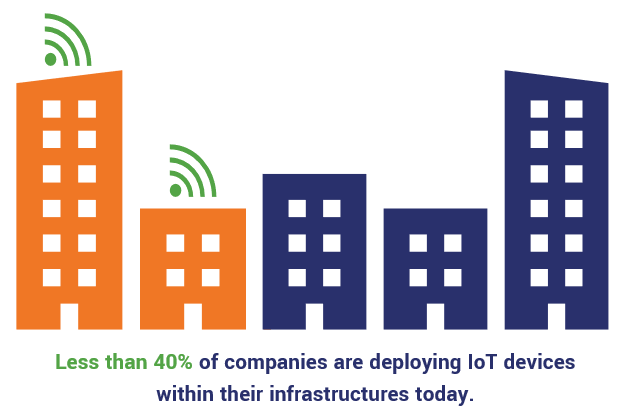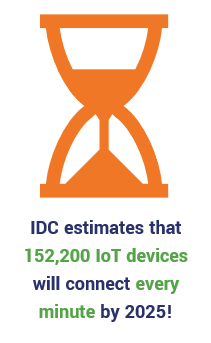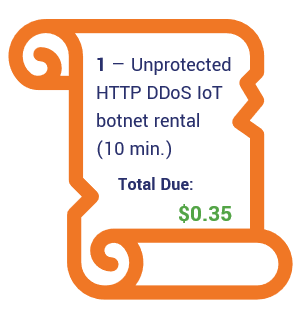Re-Hashed: 27 Surprising IoT Statistics You Don’t Already Know
The IoT device market is on the rise and is poised to reach $1.4 trillion by 2027, according to Fortune Business Insights. Check out other new IoT stats in this updated article for 2021…
The Internet of Things (IoT) has been a hot topic for decades — ever since a few Carnegie Mellon University graduate students decided to use ARPANET (the precursor to the modern Internet) and a sensory board to monitor the temperature and availability of a Coca-Cola machine’s products in the 1980s. But where is the IoT industry headed? Looking at some of the highlights from the industry’s top IoT statistics for 2021 helps to shed some light on the growth of the industry that has taken computers from being machines that once required entire rooms of space and revolutionized them into personal devices that can be worn on your wrist.
The fourth industrial revolution (4IR) is making a significant impact in our world and how we do business. Nowadays, it seems like everything is connected to the internet. Manufacturing equipment, thermostats, refrigerators, wristwatches, baby monitors, automobiles, medical devices — even door locks. (Yeah, we don’t think all of these are particularly smart, either, considering the insecurities that plague IoT devices — but, hey, whatever floats your boat.)
But the forward momentum doesn’t stop there. Companies are continually striving to make virtually everything connected — regardless of whether everyone is on the same page about such an increasing level of connectivity.
With all of this in mind, it’s no surprise that the topic of IoT statistics is also of interest to many people. After all, “internet of things statics” is a term that encompasses a lot of different areas such as:
- The overall IoT market,
- The number of IoT devices on the market,
- Attack-related statistics, and
- The frequency of use by businesses, individuals, and different industries.
So, what IoT stats made our list for 2021?
Let’s hash it out.
27 Essential Internet of Things Statistics to Keep You Up to Speed
We’ve compiled some of the top IoT statistics for 2021. It includes a mix of new and updated statistics (wherever possible) to freshen up the data from our 2019 article. (No, there wasn’t a 2020 article, sorry.) However, it’s worth noting that some of these statistics may seem a bit contradictory — but that’s because the methodologies used in the studies and calculations differ by source.
IoT Statistics: An Overview of the IoT Market
1 — The IoT Devices Market Anticipated to Top $1.3 trillion by 2026
A report by Mordor Intelligence forecasts that the global market for IoT, which was valued at $761.4 billion in 2020, will surpass $1.38 trillion ($1,386.06 billion) by 2026. This compound annual growth rate (CAGR) of 10.53%, which is estimated to occur between 2021 and 2026, is lower than previous estimates due to the impact of COVID-19 on IoT investments and deployments globally. Yet another thing you can chalk up to the effects of the global pandemic.
When we published the IoT statistics article for the first time, we included data from Fortune Business Insights, indicating that the IoT global market, which was valued at $190 billion in 2018, would reach $1.11 trillion ($1111.3 billion) by 2026. Now, Fortune Business Insights projects that the IoT market size, which was $250.72 billion in 2019, will top $1.4 trillion ($1,463.19 billion) by 2027. During the forecast period, that equates to a CAGR of 24.9%.
2 — Global IoT Healthcare Market to Reach $14 billion by 2024
Zion Market Research data indicates that the global IoT healthcare market value will reach $14 billion by 2024 — this is a CAGR of 12.2% between 2017 and 2024. They attribute the increase to the growing use of cloud computing in healthcare facilities.
3 — Global IoT Medical Devices Market to Top $62 Billion by 2025
Zion Market Research also estimates that the global IoT medical devices market is going to have a CAGR of 15.27% between 2019 and 2025. They forecast that this will result in a market worth $62.69 billion ($62,694 million) by the end of that period.
4 — 83 Billion Connections Estimated by 2024
Juniper Research reports that the “total number of IoT connections” will likely reach 83 billion by 2024. This is according to their IoT ~ The Internet of Transformation 2020 whitepaper. This is up from the 35 billion connections they reported in 2020. And the industrial sector, another of their reports shows, is the one they anticipate will lead the way.
5 — 45% of Cellular IoT Connections Will Be NB-IoT and CAT-M by 2026
In its November 2020 mobility report, Ericsson estimate that the biggest growth of cellular IoT connections will be seen in terms of NB-IoT and CAT-M technologies. NB-IoT, which stands for Narrowband IoT, and CAT-M, which includes Category M1 and M2 in their report, are both low-power wide area (LPWA) technologies.
6 — Open-Source Part of IoT Deployments for 60% of Survey Respondents
Data from the first annual IoT Commercial Adoption survey by the Eclipse Foundation shows that almost two-thirds of companies plan to make open source part of their IoT deployment plans.
7 — IoT Device-Generated Data Predicted to Reach 73.1 ZB by 2025
IDC predicts that data generated by connected IoT devices globally will grow from 17.3 zettabytes (ZB) in 2019 to 73.1 ZB by 2025. And in case you didn’t know, a zettabyte is the equivalent of 1,000,000,000,000,000,000,000 bytes, according to Technopedia. (Yeah, I didn’t know that, either.)
Now, what does IDC think will be the primary sources of all this data? They’re thinking video and security surveillance as well as industrial IoT applications.
IoT Statistics: Adoption Rates and Success
8 — COVID-19 Leads to Increasing IoT Enterprise Investments
The effects of the COVID-19 global pandemic can also be felt in IoT adoptions. Microsoft’s 2020 IoT Signals report indicates that one-in-three decision-makers plan to up their IoT investments while 41% say their existing investments will remain the same.
9 — Just Under 40% of Companies Are Deploying IoT Today

IoT is a growing area. However, the results of the Eclipse Foundation’s 2020 IoT Commercial Adoption survey caution that the growth is slower than what the “hype” surrounding IoT would lead you to believe.
Do we have their updated data? Not yet. The Eclipse Foundation’s new 2021 IoT and Edge Commercial Adoption Survey is in the works. To participate, you need to complete the survey before Feb. 28, 2021.
10 — 58% of financial executives report having well-developed IoT initiatives
A Forbes Insights survey of 700 executives, performed in collaboration with Intel, reports that financial services organizations lead the way in IoT deployment. The data shows that “close to six in 10 executives in the financial services sector, 58%, report having well-developed IoT initiatives.” The financial services industry is followed closely by the healthcare industry with 55% of survey respondents reporting having “fairly robust deployments in place.”
11 — 92% of EMEA CXOs Believe IoT to Have the Greatest Impact on Their Organizationsn is a top strategic objective 94% of executives
A Deloitte Industry 4.0 survey of 2,000+ executives across 19 countries shows that CXOs in the EMEA region estimate the biggest impact of the “big four” technologies on their organizations. This is compared to 45% and 72% of American and APAC CXOs, respectively. The technologies in question are IoT, artificial intelligence, cloud infrastructure, and big data/analytics.
12 — 72% View IoT as Having Biggest Organizational Impact
Nearly three-quarters of the same Deloitte Industry 4.0 survey respondents globally say they believe IoT will have the largest impact on their organizations. This is followed by AI (68%) and cloud infrastructure (64%).
13 — Enterprises Anticipate “Financial Payback” for IoT Investments in 3 Years
Gartner reports that almost two-thirds of enterprises — 63% — expect to achieve financial payback within three years of their Internet of Things projects.
14 — 7+ Million: How Many U.S. IoT Data Points Walmart Manages
In January 2021, Walmart shared about its use of IoT technologies at scale. In its U.S. stores alone, the corporation manages more than seven million unique data points that transmit nearly 1.5 billion messages. They currently use IoT to monitor and manage refrigeration equipment to increase efficiency. However, the article says that their use of IoT will likely expand into other areas and locations in the future.
15 — 93% of Executives View IoT as More Beneficial Than Risky
This recent data from PricewaterhouseCoopers (PwC) indicates that nine-in-10 business executives have an optimistic outlook of IoT, believing its benefits outweigh the risks. (Makes me wonder just how aware they are of IoT-related risks.) PwC tapped approximately 1,000 business executives for the 2019 IoT survey.
16 — 152,200 IoT devices per minute

IDC data estimates that 152,200 IoT devices will connect every minute by 2025. Let’s do the math: When you multiply 152,200 (the estimated number of devices connected per minute) by 525,600 (the number of minutes per standard 365-day year), the total is staggering. It means that by 2025, nearly 80 billion (79,996,320,000) devices are forecast to be connected annually.
IoT Statistics: IoT Vulnerabilities and How These Devices Are Used in Cyber Attacks
While IoT devices have many benefits, it’s no secret that they also pose as attractive attack vectors for cybercriminals. The OWASP Top 10 Internet of Things 2018 list is comprised of 10 IoT-related vulnerabilities and weaknesses, including insecure passwords, networks, and ecosystem interfaces.
IoT devices are frequently compromised and added to botnets. These dangerous networks are frequently used to launch distributed denial of service (DDoS) malware and brute-force attacks against businesses of all sizes globally. And really, their monopolization by cybercriminals should come as no surprise.
As said by Dirk Schrader, Global Vice President at New Net Technologies (NNT) in an article by Security Magazine:
“It’s no surprise that IoT devices are the crown jewels for cybercriminals. Businesses around the world are transforming their processes, their production lines using digitalized assets. Having control over these assets means that a cybercriminal’s hand is – literally – at the main switch of a digitally transformed company. The danger of being shut down almost completely is the reason why companies are more likely to pay even higher ransoms.”
Here are some IoT statistics concerning attacks on or using connected devices.
17 — Fewer than 42% of Organizations Can Identify Insecure IoT Devices
Visibility of IoT devices on your network is crucial for businesses and other organizations. But no more than two-in-five of the 630 survey respondents from a combined Ponemon Institute and Shared Assessments study (from June 2020) say their organizations can identify inadequately secured IoT devices. And to make matters worse, when they do identify those devices, only 14% step up to replace them immediately.
Nothing quite like knowing that something is likely to come back at a later time to kick you in the teeth but choosing to do nothing about it before it has a chance…. Personally, I like my teeth the way they are and want to keep ’em that way. But to each their own, I suppose.
18 — IoT Devices Typically Attacked Within 5 Minutes
Five minutes. That’s the average amount of time that it takes for an IoT device to be attacked once connected to the Internet, according to NETSCOUT’s Threat Intelligence Report from the second half of 2018. (If you’ve found a more recent number for this, be sure to let me know in the comments!)
19 — You Can Rent an IoT Botnet for as Little as $0.35

Everyone loves finding a good deal, and cybercriminals are no different. Like consumers at a store, they also shop around for good prices. Flashpoint reports in their “Pricing Analysis of Goods in Cybercrime Communities” paper that DDoS-for-Hire service rates in 2019 didn’t let them down.
For example, you could pay someone to launch a five-hour DDoS attack a site for just $250. Or, if you only want to cause a “little” problem, you could pay to rent an unprotected HTTPS DDoS IoT botnet — or a protected HTTP DDoS Windows botnet — for 10 minutes at a cost of only $0.35. Decisions, decisions.
20 — Nearly 90% of Risk Pros Think IoT Leaves Them at Risk of Cyber Attacks
The Ponemon Institute and Shared Assessments survey indicates that nine-in-10 surveyed risk professionals believe that cyber attacks and data breaches of their organizations are likely within the next two years due to unsecure IoT and applications.
21 — IoT Malware Attacks Skyrocketed in 2018, Trend Continues Through 1H 2020
SonicWall reports that IoT malware attacks jumped 215.7% to 32.7 million in 2018 (up from 10.3 million in 2017). In 2019, the attacks continued but showed a more moderate increase of “just” 5% in IoT malware, according to their 2020 SonicWall Cyber Threat Report.
SonicWall hasn’t yet released their findings from 2H 2020 (as of the writing of this updated article). However, if the pattern holds of increasing attacks in the second half of the year, then 2020’s attacks may have been greater than the recorded combined total of attacks in 2018 and 2019.
22 — Four in Five Medical Imaging Devices Use Outdated OSes
Palo Alto Networks reports in their 2020 Unit 42 IoT Threat Report that “83% of medical imaging devices are running on unsupported operating systems.” Isn’t that comforting? So glad to see that healthcare organizations really learned a lesson from the Eternal Blue exploits of 2017…
IoT Statistics: Concerns about Data Privacy
Not everyone is jumping for joy as IoT devices take a stronghold in modern technology. Here are some industry statistics concerning data privacy in the IoT era:
23 — 98% of IoT Traffic Isn’t Encrypted
Palo Alto Networks also shares in that same 2020 Unit 42 IoT Threat Report that “98% of all IoT device traffic is unencrypted, exposing personal and confidential data on the network.”
Well, that kind of number should wake you up faster than a cup of coffee. We figured it was a good one to grab your attention. Unfortunately, as you’ve seen, that wasn’t the only doozy of a stat that their report delivered.
24 — 92% of Global Consumers Want to Control Their PII
Findings from an Economist Intelligence Unit (EIU) survey of 1,600 consumers in eight countries indicate that 92% of global consumers want to control the types of personal information that organizations automatically collect about them. The same number of consumers want to increase punishments for companies that violate consumers’ privacy.
25 — 74% of Global Consumers Worry About Losing Their Civil Rights
Data from the EIU survey suggests that the majority of surveyed consumers are concerned that “small privacy invasions may eventually lead to a loss of civil rights.”
26 — 63% of Consumers Find Connected Devices “Creepy” Concerning Data Collection
While connected devices are exceedingly popular with consumers, nearly two-thirds of surveyed consumers from the U.S., U.K., Australia, Canada, France, and Japan think the way that connected devices collect data about them and their behaviors is “creepy.” This data is the result of a Consumers International and Internet Society survey on consumers’ perceptions and thoughts of consumer IoT devices.
27 — 55% of companies don’t require third-party IoT provider security & privacy compliance
The Ponemon Institute and Shared Assessment survey shows that “Less than half of respondents (47%) evaluate Third Party IoT security and privacy practices before working with those parties.” Furthermore, only 55% require remediation of any identified third-party control weaknesses.
What are some of the important and recent IoT statistics that you’ve come across in your work or research? As always, share your thoughts in the comments.






































![A Look at 30 Key Cyber Crime Statistics [2023 Data Update]](https://www.thesslstore.com/blog/wp-content/uploads/2022/02/cyber-crime-statistics-feature2-75x94.jpg)












5 Ways to Determine if a Website is Fake, Fraudulent, or a Scam – 2018
in Hashing Out Cyber SecurityHow to Fix ‘ERR_SSL_PROTOCOL_ERROR’ on Google Chrome
in Everything EncryptionRe-Hashed: How to Fix SSL Connection Errors on Android Phones
in Everything EncryptionCloud Security: 5 Serious Emerging Cloud Computing Threats to Avoid
in ssl certificatesThis is what happens when your SSL certificate expires
in Everything EncryptionRe-Hashed: Troubleshoot Firefox’s “Performing TLS Handshake” Message
in Hashing Out Cyber SecurityReport it Right: AMCA got hacked – Not Quest and LabCorp
in Hashing Out Cyber SecurityRe-Hashed: How to clear HSTS settings in Chrome and Firefox
in Everything EncryptionRe-Hashed: The Difference Between SHA-1, SHA-2 and SHA-256 Hash Algorithms
in Everything EncryptionThe Difference Between Root Certificates and Intermediate Certificates
in Everything EncryptionThe difference between Encryption, Hashing and Salting
in Everything EncryptionRe-Hashed: How To Disable Firefox Insecure Password Warnings
in Hashing Out Cyber SecurityCipher Suites: Ciphers, Algorithms and Negotiating Security Settings
in Everything EncryptionThe Ultimate Hacker Movies List for December 2020
in Hashing Out Cyber Security Monthly DigestAnatomy of a Scam: Work from home for Amazon
in Hashing Out Cyber SecurityThe Top 9 Cyber Security Threats That Will Ruin Your Day
in Hashing Out Cyber SecurityHow strong is 256-bit Encryption?
in Everything EncryptionRe-Hashed: How to Trust Manually Installed Root Certificates in iOS 10.3
in Everything EncryptionHow to View SSL Certificate Details in Chrome 56
in Industry LowdownPayPal Phishing Certificates Far More Prevalent Than Previously Thought
in Industry Lowdown